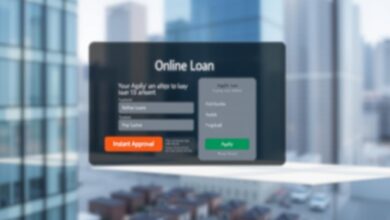Loans for Bad Credit: Get the Funding You Need
Millions of Americans face challenges with bad credit. This makes it hard to get funding when they need it. Recent data shows a big part of the population can’t get personal loans because of their credit history.
Having a poor credit score doesn’t mean you’re out of options. Loans for bad credit are made for people who can’t get traditional loans.
Our guide will show you the different bad credit loans out there. We’ll also give you a step-by-step guide on how to apply. We aim to help you through the process, so you can get the funding you need.
Key Takeaways
- Understanding the concept of loans for bad credit
- Types of bad credit loans available
- How to apply for personal loans for bad credit
- Tips for improving your credit score
- What to expect from the loan application process
Understanding Bad Credit Loans
If you have bad credit, it’s key to understand bad credit loans. Bad credit limits your loan choices. But, knowing how to find funding is possible.
What Constitutes Bad Credit?
A credit score is a three-digit number showing how good you are with money. It’s based on your past payments, how much credit you use, and how long you’ve had credit. A score under 580 is bad credit. This can happen if you pay late, use too much credit, or have other credit issues.
Here’s what affects your credit score:
| Factor | Percentage | Description |
|---|---|---|
| Payment History | 35% | On-time payments help your score. |
| Credit Utilization | 30% | Keep credit use under 30%. |
| Length of Credit History | 15% | A longer credit history is better. |
| Credit Mix | 10% | Diverse credit types improve your score. |
| New Credit | 10% | Avoid many new credit applications. |
How Bad Credit Affects Loan Options
Bad credit makes getting a loan tough. Lenders see you as riskier, leading to higher rates or tougher terms. Bad credit loans are for these situations but have less favorable terms.
Bad credit can lead to:
- Higher Interest Rates: You’ll face higher rates because of the risk.
- Stricter Terms: Terms might be harsher, like shorter payback times or bigger monthly payments.
- Lower Loan Amounts: You might get smaller loans than those with good credit.
- Additional Requirements: You might need extra collateral or a co-signer for the loan.
Knowing these points helps you make better choices when looking for a loan with bad credit.
Types of Bad Credit Loans
Exploring bad credit loans can be tough, but knowing the types helps. It’s key to remember that not all loans are the same, even for bad credit.
Personal Loans for Bad Credit
Personal loans for bad credit help with various needs like medical bills or car repairs. They’re usually unsecured, meaning no collateral is needed. But, expect higher interest rates because of the risk.
Key benefits: You can use the loan for anything, and fees might be lower than payday loans.
Secured vs. Unsecured Loans
Choosing between secured and unsecured loans is crucial with bad credit. Secured loans need collateral, like a car, and can take it if you can’t pay. Unsecured loans don’t need collateral but have higher rates or stricter terms.
| Loan Type | Collateral Required | Interest Rate | Risk Level |
|---|---|---|---|
| Secured Loan | Yes | Generally Lower | High (Risk of losing collateral) |
| Unsecured Loan | No | Generally Higher | Lower (No collateral at risk) |
Pay Day Loans: Pros and Cons
Payday loans are short-term, high-interest loans due on payday. They’re a last resort because of their costs. Yet, they offer quick cash when needed.
Knowing the different bad credit loans helps you choose wisely. Whether it’s a personal loan, secured or unsecured, or a payday loan, consider your situation well.
Where to Find Loans for Bad Credit
Finding loans for bad credit can be tricky. There are many lenders out there. It’s important to find the right one for your needs.
Online Lenders
Online lenders have changed how we get online loans for bad credit. They make applying easy and fast, unlike banks. They also look at more than just your credit score.
Online lenders offer quick applications and fast money. But, watch out for higher interest rates and fees.
Credit Unions and Community Banks
Credit unions and community banks offer personal service. They might be more willing to lend to people with bad credit. They know the local community well.
When looking at bad credit lenders like these, check their loan details. They might have better rates and terms than online lenders.
Peer-to-Peer Lending Platforms
Peer-to-peer lending connects you with investors. This can mean better deals than banks. It’s good for those with bad credit.
But, peer-to-peer lending has risks. There could be higher interest rates and fees. Always read the fine print before agreeing.
In summary, finding the right lender for bad credit loans means looking at different options. This includes online lenders, credit unions, community banks, and peer-to-peer platforms. Knowing the pros and cons helps you make the best choice for your financial situation.
Eligibility Criteria for Bad Credit Loans
Getting a loan with bad credit means knowing what lenders look for. Each lender has its own set of rules. But, there are some common things they check.
Income Requirements
Lenders want to see you have a steady income. They need to know you can pay back the loan.
Minimum Income Thresholds: Some lenders set a minimum income you must have. This amount can change a lot, depending on the lender and the loan type.
Minimum Credit Score Needed
Even though these loans are for people with bad credit, lenders still look at your credit score. The score needed is usually lower than for regular loans.
Other Factors Lenders Consider
Lenders also look at more than just your income and credit score. They might check your job history, how much debt you have, and other financial stuff.
Here’s a quick rundown of what you usually need for bad credit loans:
| Eligibility Criteria | Description | Typical Requirements |
|---|---|---|
| Income | Stable income source | Proof of employment or regular income |
| Credit Score | Minimum credit score | Varies by lender, typically lower than standard loans |
| Employment History | Stable employment | Long-term employment with the same employer |
| Debt-to-Income Ratio | Manageable debt | Debt should not exceed a certain percentage of income |
Knowing these criteria can help you get ready. It might even increase your chances of getting approved.
How to Improve Your Chances of Approval
To get a bad credit loan, you need to know what lenders look for. Focus on your credit score, debt, and the help of a co-signer. These steps can really up your chances of getting approved.
Boosting Your Credit Score
Improving your credit score is key to getting a loan. Your score shows how reliable you are with money. To boost it, pay bills on time and check your credit report for mistakes.
Strategies for Boosting Your Credit Score:
- Make all payments on time.
- Keep credit utilization below 30%.
- Monitor your credit report for errors.
- Avoid applying for too much credit at once.
Reducing Existing Debt
Lowering your debt can also help. Too much debt makes you look riskier to lenders. Paying down debt improves your score and shows you can handle money.
Consider the following debt reduction strategies:
- Prioritize debts with the highest interest rates.
- Consolidate debt into a single, lower-interest loan or credit card.
- Create a budget that allocates a significant portion towards debt repayment.
Providing a Co-Signer
Having a co-signer can also boost your chances. A co-signer takes on the loan if you can’t pay. This makes lenders feel safer, which is great for those with very bad credit.
| Strategy | Impact on Credit Score | Impact on Loan Approval |
|---|---|---|
| Boosting Credit Score | Positive | Higher Approval Chances |
| Reducing Existing Debt | Positive | Higher Approval Chances |
| Providing a Co-Signer | N/A | Significantly Higher Approval Chances |
Understanding Interest Rates
When you apply for a bad credit loan, the interest rate is key. It greatly affects the loan’s total cost. It’s important to know how interest rates work and what affects them.
Bad credit loans have higher interest rates than regular loans. This is because lenders take more risk by lending to people with poor credit. The Annual Percentage Rate (APR) includes the interest rate and other fees.
Factors Influencing Interest Rates
Several things can change the interest rate on a bad credit loan. These include:
- Credit Score: Even with bad credit, a slightly better score can lead to a better rate.
- Loan Amount: The loan size can also affect the rate. Larger loans might have different rates than smaller ones.
- Repayment Term: The loan term can change the rate too. Longer terms might mean lower monthly payments but more interest over time.
- Lender Policies: Each lender has its own way of setting rates. Shopping around can help you find a better rate.
Knowing these factors can help you find a better interest rate. This can make a big difference in your loan costs.
Comparing Loan Offers
When comparing loans, don’t just look at the interest rate. The APR is more important. It shows the total cost, including fees. Be careful of loans with high APRs as they can trap you in debt.
To compare loans well:
- Look at the total cost of the loan, not just the monthly payment.
- Think about the repayment term and how it affects the total interest.
- Check for any extra fees, like origination or late fees.
By looking at these details, you can make a smarter choice. This helps you find a loan that fits your financial needs.

The Application Process
Applying for a loan can seem tough, but knowing the steps helps. When you apply for bad credit loans, being ready with the right documents is key.
Common Application Requirements
To get a bad credit loan, you’ll need to provide some documents. These include:
- Identification proof (driver’s license, passport, etc.)
- Income proof (pay stubs, bank statements, etc.)
- Credit reports or credit scores
- Employment history
- Personal references
Having these documents ready can make the process smoother. Some lenders even offer online applications for convenience.
What to Expect After Applying
After you apply, the lender will check your credit and other details. This can take different amounts of time, depending on the lender and loan type.
Some lenders provide instant approval loans or pre-approval. This is great for urgent needs. But, even with instant approval, it might take a few days to get the money.
Here’s what you might see during the approval process:
| Step | Description | Timeline |
|---|---|---|
| Application Review | Lender reviews your application and credit history | 1-3 business days |
| Approval Decision | Lender makes a decision on your loan application | 1-5 business days |
| Fund Disbursement | Loan amount is disbursed to your account | 1-7 business days |
Knowing these steps can help you understand the loan application process better. It also helps manage your expectations.
Loan Terms to Be Aware Of
It’s important to know the terms of a bad credit loan to avoid financial surprises. When we apply for a loan, we must understand the conditions set by lenders.
Repayment Periods
The repayment period is key in any loan. It’s the time we have to pay back the loan fully. Repayment periods vary a lot among lenders, from a few months to years. Bad credit loans often have shorter periods to reduce risk.
For example, payday loans are due by our next payday. Longer periods mean smaller monthly payments but more interest. Shorter periods mean bigger payments but less interest. We should pick a period that fits our budget.
Fees and Penalties
Lenders may add fees and penalties to bad credit loans. These include origination fees, late payment fees, and prepayment penalties. Origination fees are a percentage of the loan when it’s issued. Late fees happen if we miss a payment. Prepayment penalties are for paying off early.
To avoid extra costs, we should read the loan agreement carefully. It’s wise to ask about fees and understand when they apply. For more on loan types and terms, visit Consumer Finance.gov.
Knowing these terms helps us make smart choices and avoid financial trouble. Always read the fine print and ask questions if unsure.
Pros and Cons of Bad Credit Loans
It’s important to know the good and bad sides of bad credit loans. They can be a big help in tough financial times. But, they also have risks that you should think about carefully.
Advantages of Getting a Bad Credit Loan
One big plus of bad credit loans is they give you money when you can’t get it elsewhere. People with bad credit often struggle to get loans from regular banks. But, bad credit loans are there as an option.
These loans can be used for many things like paying off debt, covering sudden bills, or buying big items. Also, making payments on time can help improve your credit score. This is a step towards better financial health. For more details, check out Bankrate’s guide on bad credit personal.
Potential Risks and Drawbacks
Even with their benefits, bad credit loans have big downsides. One major issue is the high interest rates. Because of the risk, lenders charge more. This means you’ll pay more each month, making it hard to pay back the loan.
Another risk is the fees and penalties. Fees for late payments, origination, and more can quickly increase the loan’s cost. Always check the loan terms before agreeing to anything.

| Loan Type | Interest Rate | Repayment Terms |
|---|---|---|
| Bad Credit Loan | High (15%-30% APR) | Short to Medium Term (1-5 years) |
| Good Credit Loan | Low (5%-10% APR) | Medium to Long Term (5-10 years) |
In summary, bad credit loans can be a lifesaver but you need to know the good and bad. Understanding both sides helps you make choices that fit your financial situation.
Alternatives to Bad Credit Loans
If you have bad credit, there are better ways to handle your money than bad credit loans. These loans might seem quick fixes but often have high interest rates. Looking into other options can lead to better financial health.
Credit Counseling Services
Credit counseling services help manage debt in a structured way. They offer advice on budgeting, talking to creditors, and improving your credit score. Working with a credit counselor can help you understand your finances better and make smart money choices.
Benefits of Credit Counseling:
- Personalized financial planning
- Debt management plans tailored to your needs
- Improved credit score over time
Secured Credit Cards
Secured credit cards are a good alternative to bad credit loans. They require a deposit that acts as your credit limit. Using them wisely can help improve your credit score.
Key Features to Look for in a Secured Credit Card:
- Low or no annual fees
- Reporting to major credit bureaus
- Potential for credit limit increases
| Feature | Secured Credit Card | Unsecured Credit Card |
|---|---|---|
| Security Deposit | Required | Not Required |
| Credit Limit | Typically lower | Varies based on creditworthiness |
| Annual Fees | Can be lower | Can be higher |
Government Assistance Programs
Government programs can offer big help if you qualify. They help with housing, food, and healthcare. These programs can ease financial stress and help you focus on improving your credit.
“Government assistance programs can be a vital lifeline for individuals facing financial hardship, providing support that can help stabilize their financial situation.”
Exploring these alternatives to bad credit loans can lead to better financial choices. They offer long-term benefits for your financial health.
Real-Life Success Stories
We’ve seen how bad credit loans change lives for the better. They offer financial relief and help people get back on their feet. Many have used these loans to improve their credit scores and achieve financial stability.
People Who Improved Their Credit
Many people have benefited from bad credit loans. They’ve used these loans to rebuild their credit. For example, Jane Doe, a single mom from Ohio, consolidated her debt and boosted her credit score by 100 points in a year.
“I was skeptical at first, but the bad credit loan helped me cover my expenses and start rebuilding my credit. Now, I’m in a much better financial position.” – Jane Doe
John Smith from California also improved his credit. He used a bad credit loan to pay off high-interest debts. This allowed him to buy a home in just two years, greatly improving his credit history.
How Loans Helped Them
These loans gave these individuals the financial freedom they needed. They helped pay off debts or cover emergencies. This allowed them to make timely payments and show they could handle their finances.
The secret to their success was understanding their loan terms and making consistent payments. As John Smith said, “The loan wasn’t just a financial solution; it was a chance to prove to myself that I could manage my finances better.”
- Consolidated debts into a single, manageable loan
- Made timely payments to improve credit scores
- Achieved long-term financial stability
These stories show the good side of bad credit loans when used wisely. They offer a way to get back on track financially and improve credit health.
Frequently Asked Questions
We’ve talked about bad credit loans, and now we answer some common questions. Knowing these answers can help you understand how to get a bad credit loan.
Eligibility with No Credit History
Getting a loan without a credit history is tough, but it’s doable. Lenders look at more than just your credit score. They might check your income and job history. We’ve seen people with no credit history get loans.
Loan Funding Time
The time it takes to get your loan funds varies. Some online lenders are quick, often in a few days. It’s important to know the loan terms and how fast the lender works.
Understanding these points about bad credit loans can help you make better choices. We hope this info helps you feel more confident in your financial decisions.









